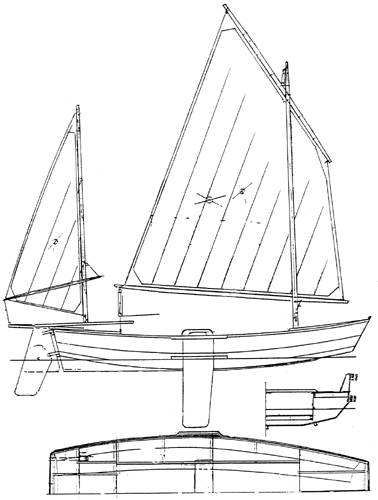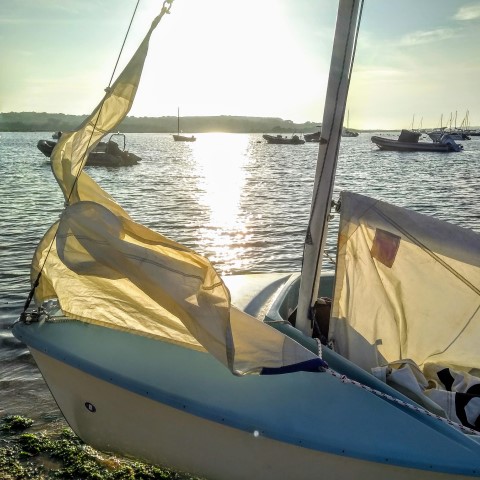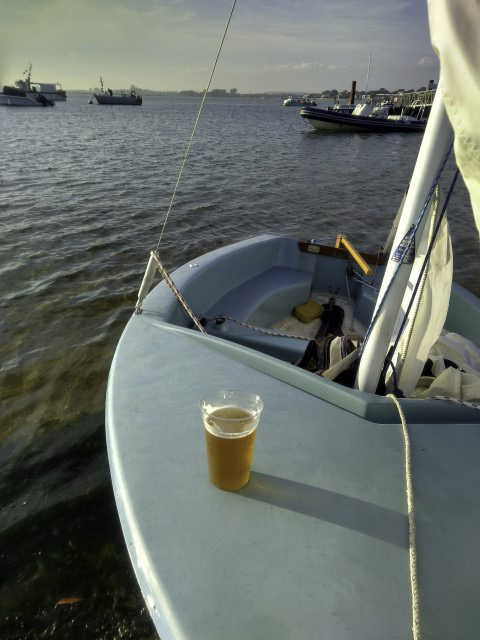Journey to Building my own Boat
I have taken the plunge and am building a Paul Fisher Skylark 14 at home in my small garage.

Since I sold my Flicka 20 some years ago I have yearned for another boat. I have been making do with a Proctor Gull Mk3 dinghy which is a great little boat for what it is and an ideal choice for a single person or small family to get out on the water easily. It has fit my needs very well over the past few seasons.
Where I sail in Christchurch harbour in Dorset is very shallow and usage tends to be a gentle sail around the harbour followed by a cup of coffee (or a pint of lager) and a picnic on Mudeford spit. Even in the Gull at high tide we hit the bottom all the time.
Being an old and battered boat I don't have to worry about the Gull much so it's kept at the dinghy park on a trolley year round. I don't even have a trailer to bring it home to work on. She just sits there under cover and I go down from time to time and drain the water and take her out.

Having the Gull in the dinghy park got me thinking again (dangerous I know) about the practicalities of boating. You see I have experienced owning a proper boat, both in a marina and on a mooring and I can now see all the pros and cons. Having the Caraway on a mooring was trouble. The birds would crap all over her and I'd spend more time cleaning her than sailing her. Someone crashed into the back of her causing thousands of pounds worth of damage and didn't even leave a note. One night someone got on board and broke in and threw the teak washboards into the river. I was very lucky to find them on the bank at the nearest bend down stream. Owning a proper boat but not living on board was difficult.

One could have a boat on a trailer and keep it at home. But then where I live you often have to pay to use the slipway and then you have to pay for parking and you have to wait for someone else with three jet skis and kids and a dog. Some people take an age rigging and launching their boats. Plus you have to drive. I want to be able to get on my bike and ride down to the boat and go sailing in 20 minutes. The dinghy park gives me that option. I lock my bike to the chains, rig the boat and am soon on the water.
But the problem is that I want a boat that does more than most dinghies and yet is still light enough to be able to launch single handed on a trolley. What if I wanted to sleep on board from time to time? What if I wanted to take three adults, four kids and a dog over to the spit for the day? What if I wanted to take three people fishing?
The Gull is not stable or big enough for any of this. It is not really stable enough to relax when single handed. For fishing I'd really have to take the mast off. But she's sloop rigged and that's not simple. Great boat though she is I started to wonder what else I could fit into a 15 foot dinghy space that would give me more options. What I really needed was a general purpose sailing boat with more stability yet light enough to handle single handed.
I've looked at a lot of boats to fit my needs and come to the conclusion that there really are no production boats that do. Almost all of the dingies that you can buy new are for racing. There are some that people use for cruising but they still didn't work for me. The Wayfarer is too heavy. The Wanderer is also fairly heavy and doesn't have such good internal space for sleeping. She is sloop rigged which is complicated and the mast does not fit into the boat. The Wanderer, like most dinghies has a centreboard case in the middle. The interior space is not designed to lie down in. Most people "make do" for dinghy cruising.
I became interested in the balanced lug rig having read about how much sense it makes for small cruising boats. A simple standing lug well made and set up with modern running rigging is very efficient. It is also way simpler than a sloop. There is no standing rigging and only one sail so the number of blocks and other hardware is greatly reduced. This means a big reduction in cost as well as complexity.
There are many small cruising type boats that are great and there a lots of them available used. But nearly all of them are too heavy to launch from a trolley. They have to be either kept on a mooring or launched with a car on a road trailer. So I set about finding some designs that were light and designed for cruising.
I soon realised that if I wanted something that fit my needs I was going to have to build it myself. There is a busy community of small boat enthusiasts online and I started to look at various designers and their work. The ones that stood out were John Welsford, Jim Michalak, Ross Lillistone, Dudley Dix and Selway Fisher.
Eventually, I narrowed it down to a few. I liked a lot of Welsford's boats, especially Houdini and Navigator but after having looked at other people's build logs I realised that I was not going to have time for such a complicated project. I needed a simpler boat or a kit or both. I came across the Goat Island Skiff (GIS) which I like very much but soon found it that it was not stable enough to sleep on board comfortably. The GIS is very light which made me realise that it should be possible to have a boat around 15 foot that I can launch from a trolley and be stable enough for my needs.
I looked at a lot of Michalak's designs and was attracted to the Mayfly 14 amongst others. But I wasn't quite convinced enough by any of them.
Ross Lillistone has designed the First Mate which is a stitch and glue dinghy around 15' in length and light enough to trolley launch. There are options to sleep aboard and she is a pretty and practical boat almost ideal for my needs. Ross was incredibly helpful and attentive to my enquiries and there was a lot to get excited about. He sent me comprehensive study plans which were full of great tips on how to build a stitch and glue boat.
I also looked at Dudley Dix's Argie 15 and even bought the plans. The Argie was almost ideal. I did a lot of research and found a plan for a lug rig. I even enquired about the price of a kit from Jordan boats.
However, I started to think more about the practicalities of the build process. The Argie is wide and long. My garage is only about 8' by 15.5'. A boat like the Argie or the First Mate was going to be a challenge to build in there. The Argie is around the same size as a Wayfarer, although she is way lighter. Launching an Argie on a trolley should be possible. But, being six foot wide and only just shy of the length of the garage she was going to be a struggle to build at home. I was also not entirely happy with the centreboard option. Not having the default dagger board meant a centre board that comes up through the middle seat getting in the way of rowing.
I have long been intrigued by the idea of lee boards or rather pivoting side mounted dagger boards and Michalak's reasoning was very illuminating. On small boats they make a lot of sense. Water always splashes up out of my Gull centre board casing which is annoying. A cruising boat needs to be as dry as possible. I know that this can be remedied with flanges and so on but what if we did away with that whole leaky contraption anyway? If you have a side mounted board you can do away with the heavy casing and free up the interior space. You just need some light but strong bracing instead. People that have lee boards seem to like them; a lot.
So where could I find a boat design with a lee board that I could build at home that would still be light and stable enough for my needs? Enter Selway Fisher. While perusing Paul Fisher's designs I came across his Skylark range. These are pram dinghies up to 14' with various rig and board options. Then I saw the Skylark 14 Mk3 and was intrigued. The pram style made a lot of sense. Being 14' long she might be similar to some 15 foot boats with the bow cut off. She was also a bit narrower than many. At 4' 10" she would give me a reasonable amount to space to work around her in the garage. At around 109 kg she should be light enough to keep on a trolley and to launch alone. In Paul Fisher's words she has "fairly vertical sides which means, for her beam, she has a generous waterline beam and plenty of stability". So she should be good for fishing and camping. With guidance use at 4-5 adults she should be ideal for harbour trips with friends and family.
The only real concern I had with her with was that I couldn't find anyone online that had built one. This was a big contrast to the GIS, Argie 15, First Mate and many Welsford designs where there were active communities on social media. I was concerned that it was difficult to really see what she was going to look like beyond the plans. All I found was one other guy that had built a Skylark 12. Thankfully he was very pleased with his boat. He had raised the free board and done various other things and was on the whole very pleased with is boat. He said she was "very stable". One would hope the 14 is also very stable.
So I decided to take the plunge and bought the plans. If I built one and put the story online then perhaps I'd get other people inspired. Selway Fisher is also a British designer and it felt right to support local business.
When I was finally ready to get started I got in touch with Alec Jordan at Jordan boats. He was also very helpful and gave me a quote for digitising the plans and cutting the panels. I had decided early on to get the panels cut on a CNC machine. I don't have a huge amount of time for the project with work and family commitments and I realised that marking out and cutting 8 foot panels in a small garage was not my idea of fun. There was huge scope for error. The precision of panels cut by computer and the time saved was well worth the cost in my situation. I was still going to have to scarf the panels together but Alec has a clever system to assist in this. The panels are labelled and come with a diagram showing their orientation and how to align them. Each panel has various pin holes. By inserting panel pins into the holes and lining up with a piece of string it's possible to easily and accurately align the scarfs before glueing up.
The panels also have pin holes marking both the centre line of the boat and where the bulk heads go. Very useful for an amateur like myself.
The Skylark 14 mk3 plans come with a Lug yawl rig. Although this is more complicated than I had intended I began to warm to the idea when I realised some of the benefits of a yawl. You have a riding sail which IS nice at anchor and for fishing. You have better heave-to options and you have two poles across which to rig an awning. I asked Paul Fisher about going to single mast and he said I'd have to move the main mast back about 400mm to make it work. So I have that option. I've decided to wait and see what the interior space looks like when I've put the hull together and decid then. I like the fact that the main mast is way forward and out of the way and the central area is very open with Paul's design. But I could have two mast positions so I could have both. We'll see as the hull takes shape.
Currently I have scarfed all the plank sections together and made a rudder and lee board. These need glassing and finished before I can move on.
Build photos can be found here: Skylark 14 Build log.
